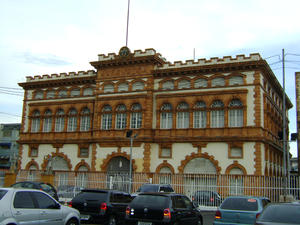 Alfândega - MAP The whole architecture of the Guard and Customs Moria was listed as a National Heritage in 1987, along with the Port Complex. Officially opened in 1906, both buildings were built by British firm Manaos Harbour Limited, as part of the contract granting the Port of Manaus. In eclectic style, with medieval and Renaissance elements, this is the first prefabricated building in the world.
The building of Moria Guard, with its tower and li... Alfândega - MAP The whole architecture of the Guard and Customs Moria was listed as a National Heritage in 1987, along with the Port Complex. Officially opened in 1906, both buildings were built by British firm Manaos Harbour Limited, as part of the contract granting the Port of Manaus. In eclectic style, with medieval and Renaissance elements, this is the first prefabricated building in the world.
The building of Moria Guard, with its tower and li... |
| Capela do Pobre Diabo - MAP The neighborhood of Cachoeirinha in Manaus, holds many stories since its colonization. One is the origin of the chapel of the Poor Devil Borba located on the street (old square Floriano Peixoto). It is said that in 1882, a Portuguese citizen named Jose Antonio da Costa, who owns a grocery store down the street from City Center Installation, ordered a tablet depicting a man clad in rags and below that reads: "The poor devil" . As he was ... |
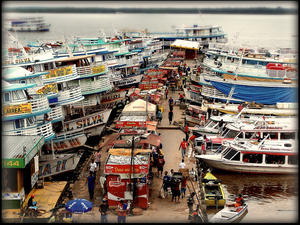 Conjunto Arquitetônico do Porto de Manaus - MAP The Architectural Group of the Port of Manaus, listed as a National Heritage in 1987, consists of several buildings: the building of the island of São Vicente (Rua Bernardo Ramos), the Central Office building (Taqueirinho Street), Museum of Porto (Boulevard Vivaldo Lima), where does the annex building of the Legislative Assembly (Rua Vittorio Governor) and the old building of the public treasury (Rua Mauricio de Souza).
Comprises Ca... Conjunto Arquitetônico do Porto de Manaus - MAP The Architectural Group of the Port of Manaus, listed as a National Heritage in 1987, consists of several buildings: the building of the island of São Vicente (Rua Bernardo Ramos), the Central Office building (Taqueirinho Street), Museum of Porto (Boulevard Vivaldo Lima), where does the annex building of the Legislative Assembly (Rua Vittorio Governor) and the old building of the public treasury (Rua Mauricio de Souza).
Comprises Ca... |
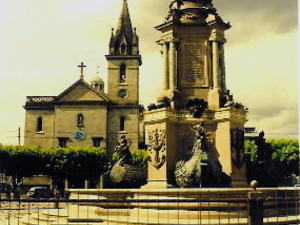 Igreja de São Sebastião em Manaus - MAP Under the direction of Gesualdo Marchetti Lucas in 1888, the building of the Church of St. Sebastian, in Manaus, Amazonas state, is neoclassical, with some elements medievalists, and its interior is marked by stained glass panels and Europeans, and the style of the time.
Intact, the paintings covering the ceiling down the aisle, including the dome and the walls, brought from Italy and posted on the site are written by Silvio Centofan... Igreja de São Sebastião em Manaus - MAP Under the direction of Gesualdo Marchetti Lucas in 1888, the building of the Church of St. Sebastian, in Manaus, Amazonas state, is neoclassical, with some elements medievalists, and its interior is marked by stained glass panels and Europeans, and the style of the time.
Intact, the paintings covering the ceiling down the aisle, including the dome and the walls, brought from Italy and posted on the site are written by Silvio Centofan... |
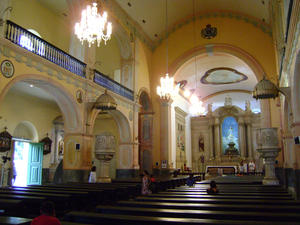 Igreja Matriz de Nossa Senhora da Conceição - MAP The Catholic Church in the city of Manaus, the trip back to the Infantry Captain Pedro Favela da Costa in 1668. On this occasion it was established the first urban center in the river mouth Tarumã, in whose place was erected a cross. It was the beginning of a warehouse for the enslavement of Indians.
It was part of the entourage of Peter Favela da Costa, Father Theodosius da Veiga, the Order of Mercy, a founder of the first chapel o... Igreja Matriz de Nossa Senhora da Conceição - MAP The Catholic Church in the city of Manaus, the trip back to the Infantry Captain Pedro Favela da Costa in 1668. On this occasion it was established the first urban center in the river mouth Tarumã, in whose place was erected a cross. It was the beginning of a warehouse for the enslavement of Indians.
It was part of the entourage of Peter Favela da Costa, Father Theodosius da Veiga, the Order of Mercy, a founder of the first chapel o... |
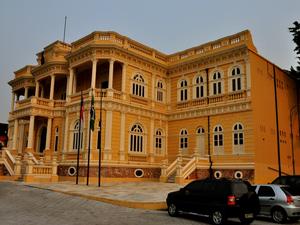 Palácio da Justiça Courthouse - MAP Located on Avenida Eduardo Ribeiro, Manaus one of the key, the Palace of Justice was inaugurated in 1900. The building was built on a raised area is protected by a thick wall with balustrades. This building is part of the urban revolution promoted by the governor Eduardo Ribeiro, Manaus. The land was expropriated in 1893 and the following year's liability was in charge of the construction firm Morton & Moers. The work, however, was comp... Palácio da Justiça Courthouse - MAP Located on Avenida Eduardo Ribeiro, Manaus one of the key, the Palace of Justice was inaugurated in 1900. The building was built on a raised area is protected by a thick wall with balustrades. This building is part of the urban revolution promoted by the governor Eduardo Ribeiro, Manaus. The land was expropriated in 1893 and the following year's liability was in charge of the construction firm Morton & Moers. The work, however, was comp... |
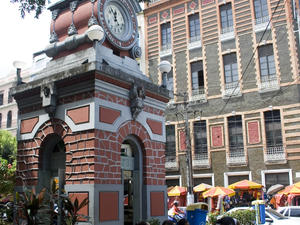 Relógio Municipal de Manaus - MAP 3 Installed at the beginning of Avenida Eduardo Ribeiro, the Clock Hall was imported from Switzerland and mounted on a stone base by local firm Pelosi & Roberti, artisan of Manaus.
The construction of its pedestal was completed in late 1927, along with the obelisk erected to commemorate the centenary of the elevation of Manaus to city.
The Municipal Clock compose the architectural landscape of the Largo in downtown Manaus.
It's f... Relógio Municipal de Manaus - MAP 3 Installed at the beginning of Avenida Eduardo Ribeiro, the Clock Hall was imported from Switzerland and mounted on a stone base by local firm Pelosi & Roberti, artisan of Manaus.
The construction of its pedestal was completed in late 1927, along with the obelisk erected to commemorate the centenary of the elevation of Manaus to city.
The Municipal Clock compose the architectural landscape of the Largo in downtown Manaus.
It's f... |
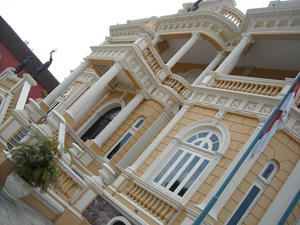 Rio Negro Palace - MAP 3 Scholz The Palace was built in eclectic style in 1903 to be the private residence of a wealthy merchant of rubber, the German Karl Waldemar Scholz. The Amazon was at the era of a more prosperous states of the Union at the Rubber Cycle.
From 1911, due to strong competition from Asian production gum trees on land, there was the imminent decline of the Amazon rubber trade. Moreover, with the advent of World War I, the shipping line bet... Rio Negro Palace - MAP 3 Scholz The Palace was built in eclectic style in 1903 to be the private residence of a wealthy merchant of rubber, the German Karl Waldemar Scholz. The Amazon was at the era of a more prosperous states of the Union at the Rubber Cycle.
From 1911, due to strong competition from Asian production gum trees on land, there was the imminent decline of the Amazon rubber trade. Moreover, with the advent of World War I, the shipping line bet... |
| Ruins of Paricatuba - MAP Old building guest Spanish emigrants now totally abandoned, just made up by the roots of nature.
In front of the building secular Apuizeiros invaded by arms, it is difficult to imagine that in 1889 he was a model of architectural sophistication. The so boarding house for Italian immigrants, from Europe to work in the state - was rich in luxury and sophistication.
The masonry structure was built with bricks and beams Portugue... |
 Alfândega - MAP The whole architecture of the Guard and Customs Moria was listed as a National Heritage in 1987, along with the Port Complex. Officially opened in 1906, both buildings were built by British firm Manaos Harbour Limited, as part of the contract granting the Port of Manaus. In eclectic style, with medieval and Renaissance elements, this is the first prefabricated building in the world.
The building of Moria Guard, with its tower and li...
Alfândega - MAP The whole architecture of the Guard and Customs Moria was listed as a National Heritage in 1987, along with the Port Complex. Officially opened in 1906, both buildings were built by British firm Manaos Harbour Limited, as part of the contract granting the Port of Manaus. In eclectic style, with medieval and Renaissance elements, this is the first prefabricated building in the world.
The building of Moria Guard, with its tower and li... Conjunto Arquitetônico do Porto de Manaus - MAP The Architectural Group of the Port of Manaus, listed as a National Heritage in 1987, consists of several buildings: the building of the island of São Vicente (Rua Bernardo Ramos), the Central Office building (Taqueirinho Street), Museum of Porto (Boulevard Vivaldo Lima), where does the annex building of the Legislative Assembly (Rua Vittorio Governor) and the old building of the public treasury (Rua Mauricio de Souza).
Comprises Ca...
Conjunto Arquitetônico do Porto de Manaus - MAP The Architectural Group of the Port of Manaus, listed as a National Heritage in 1987, consists of several buildings: the building of the island of São Vicente (Rua Bernardo Ramos), the Central Office building (Taqueirinho Street), Museum of Porto (Boulevard Vivaldo Lima), where does the annex building of the Legislative Assembly (Rua Vittorio Governor) and the old building of the public treasury (Rua Mauricio de Souza).
Comprises Ca... Igreja de São Sebastião em Manaus - MAP Under the direction of Gesualdo Marchetti Lucas in 1888, the building of the Church of St. Sebastian, in Manaus, Amazonas state, is neoclassical, with some elements medievalists, and its interior is marked by stained glass panels and Europeans, and the style of the time.
Intact, the paintings covering the ceiling down the aisle, including the dome and the walls, brought from Italy and posted on the site are written by Silvio Centofan...
Igreja de São Sebastião em Manaus - MAP Under the direction of Gesualdo Marchetti Lucas in 1888, the building of the Church of St. Sebastian, in Manaus, Amazonas state, is neoclassical, with some elements medievalists, and its interior is marked by stained glass panels and Europeans, and the style of the time.
Intact, the paintings covering the ceiling down the aisle, including the dome and the walls, brought from Italy and posted on the site are written by Silvio Centofan... Igreja Matriz de Nossa Senhora da Conceição - MAP The Catholic Church in the city of Manaus, the trip back to the Infantry Captain Pedro Favela da Costa in 1668. On this occasion it was established the first urban center in the river mouth Tarumã, in whose place was erected a cross. It was the beginning of a warehouse for the enslavement of Indians.
It was part of the entourage of Peter Favela da Costa, Father Theodosius da Veiga, the Order of Mercy, a founder of the first chapel o...
Igreja Matriz de Nossa Senhora da Conceição - MAP The Catholic Church in the city of Manaus, the trip back to the Infantry Captain Pedro Favela da Costa in 1668. On this occasion it was established the first urban center in the river mouth Tarumã, in whose place was erected a cross. It was the beginning of a warehouse for the enslavement of Indians.
It was part of the entourage of Peter Favela da Costa, Father Theodosius da Veiga, the Order of Mercy, a founder of the first chapel o... Palácio da Justiça Courthouse - MAP Located on Avenida Eduardo Ribeiro, Manaus one of the key, the Palace of Justice was inaugurated in 1900. The building was built on a raised area is protected by a thick wall with balustrades. This building is part of the urban revolution promoted by the governor Eduardo Ribeiro, Manaus. The land was expropriated in 1893 and the following year's liability was in charge of the construction firm Morton & Moers. The work, however, was comp...
Palácio da Justiça Courthouse - MAP Located on Avenida Eduardo Ribeiro, Manaus one of the key, the Palace of Justice was inaugurated in 1900. The building was built on a raised area is protected by a thick wall with balustrades. This building is part of the urban revolution promoted by the governor Eduardo Ribeiro, Manaus. The land was expropriated in 1893 and the following year's liability was in charge of the construction firm Morton & Moers. The work, however, was comp... Relógio Municipal de Manaus - MAP 3 Installed at the beginning of Avenida Eduardo Ribeiro, the Clock Hall was imported from Switzerland and mounted on a stone base by local firm Pelosi & Roberti, artisan of Manaus.
The construction of its pedestal was completed in late 1927, along with the obelisk erected to commemorate the centenary of the elevation of Manaus to city.
The Municipal Clock compose the architectural landscape of the Largo in downtown Manaus.
It's f...
Relógio Municipal de Manaus - MAP 3 Installed at the beginning of Avenida Eduardo Ribeiro, the Clock Hall was imported from Switzerland and mounted on a stone base by local firm Pelosi & Roberti, artisan of Manaus.
The construction of its pedestal was completed in late 1927, along with the obelisk erected to commemorate the centenary of the elevation of Manaus to city.
The Municipal Clock compose the architectural landscape of the Largo in downtown Manaus.
It's f... Rio Negro Palace - MAP 3 Scholz The Palace was built in eclectic style in 1903 to be the private residence of a wealthy merchant of rubber, the German Karl Waldemar Scholz. The Amazon was at the era of a more prosperous states of the Union at the Rubber Cycle.
From 1911, due to strong competition from Asian production gum trees on land, there was the imminent decline of the Amazon rubber trade. Moreover, with the advent of World War I, the shipping line bet...
Rio Negro Palace - MAP 3 Scholz The Palace was built in eclectic style in 1903 to be the private residence of a wealthy merchant of rubber, the German Karl Waldemar Scholz. The Amazon was at the era of a more prosperous states of the Union at the Rubber Cycle.
From 1911, due to strong competition from Asian production gum trees on land, there was the imminent decline of the Amazon rubber trade. Moreover, with the advent of World War I, the shipping line bet...